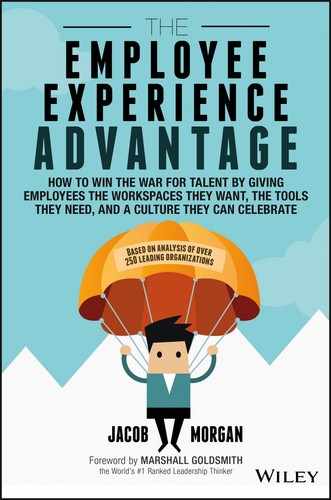CHAPTER 27
Size, Industry, and Location Don't Matter
As you can imagine, it's quite a bit easier to focus on employee experiences if you're a growing company that has to invest actively in culture, new technologies, and physical spaces. Newer companies don't have the baggage of dealing with many of the outdated workplace practices and approaches that plague many of the older and larger organizations around the world. The concept of employee experience applies to any organization regardless of size, industry, or location. Smaller, less established organizations have the benefit of being able to make these changes quicker without having to get rid of older approaches, but on the other hand, these smaller organizations also have fewer resources to work with.
I'll be honest; larger organizations here are going to have a more challenging time, simply because these organizations have more people, which means more bureaucracy, and because they usually have to change many years of doing things. Although some of the Experiential Organizations mentioned in this book are young disruptors, such as Airbnb and Facebook, there are also plenty of larger, more established players that have had to make considerable investments and changes. Consider Microsoft, which was founded in 1975 and has around 115,000 employees around the world, or Apple, which was founded in 1976 and has around 115,000 employees as well.
The size, industry, or location of an organization is not an excuse for not investing in employee experience. It's simply a matter of priority and commitment. Still, I will acknowledge that all the Experiential Organizations can be considered technology companies. It's hard to say whether this is a coincidence or is industry specific. After all there are many other technology companies, such as HP and Ingram Micro, which scored rather poorly. It's becoming harder to differentiate organizations by industry as every company is becoming a technology company. For those that prefer to stick to traditional industry definitions though, rest assured that plenty of nontechnology companies were quite close to becoming Experiential Organizations. Starbucks, Nike, Humana, Capital One, Dow Chemical, St. Jude Children's Research Hospital, Best Buy, Whirlpool, and dozens of others were all ranked as preExperiential, meaning they were in the second‐highest category of organizations. I fully expect that over time, we will see more organizations follow what I like to call the path to the Experiential Organization.
As I mentioned earlier in this book, organizations can just as easily fall backward as they can move forward. You can see this in figure 27.1. Any organization can follow the approaches outlined here. But, several specific traits of Experiential Organizations outlined in this book truly set them apart from everyone else.

Figure 27.1 Path to the Experiential Organization
ALWAYS IMPROVE
As you saw throughout this book, even the Experiential Organizations are flawed. That doesn't keep them from constantly trying to improve. These organizations know the areas they are lacking in, and they are constantly looking for ways to get better. It's okay to admit you are not perfect but always reach for the stars.
THINK LIKE A LABORATORY
As new approaches get introduced and as the discussions about the future of work continue to evolve, the Experiential Organizations evolve. These companies think of themselves as laboratories that are constantly testing, experimenting, and using data to evolve. Try to break things and then rebuild them where they come out better faster and stronger. Think of the various hackathons that organizations like LinkedIn and T‐Mobile host.
MOVE BEYOND CHECKLISTS
I've repeated this numerous times. Any organization can follow the approaches outlined in this book, but simply implementing a program around the 17 variables won't guarantee anything. The variables and environments outlined in this book are simply the things that employees care about most. I did my best to share some frameworks, models, and ideas for how you can design and implement them, but I recommend that you build on this with your own take. Remember, employee experience is not just about what you do but also about how you do it.
PUT PEOPLE AT THE CENTER AND KNOW THEM
If you truly want to be an Experiential Organization, then put your people at the center. Don't just talk about or say how much you care about your employees. Actually do something about employee experience. If employee experience is a priority, then you should make significant investments in this space. Redesign your organization to put people at the center.
Experiential Organizations truly know their people, not just from a people analytics standpoint but also from an individual manager to employee perspective. Employees are viewed as whole people with passions, fears, interests, and aspirations.
DESIGN WITH, NOT FOR
It's tempting to create things for your employees, but the right approach is to create things with them. Be as transparent as you can, and ask for feedback often both via technology and via in‐person discussions. Create the employee experience design loop, and bring employees into the experience design process whenever and wherever you can.
CARE
You can't teach this or somehow create a sense of caring. This ultimately stems from the executives running the organization and the managers who are leading the teams. If your leaders don't care about people, actually care, then no amount of effort or investment in employee experience will yield results.
FOCUS ON WHAT MAKES YOU UNIQUE
You've read about dozens of organizations in this book. Some of the examples you will be able to relate to and others you won't. Don't worry about copying anyone else. Use the examples and the stories in this book to focus on what makes you unique, and build on that as much as you can. People work at your company not because you're copying Google or Facebook, but because you are you.
